CIPD 2 Assignment: Labor Market Trends, Retention, and Future Skills
VerifiedAdded on 2023/05/28
|8
|2272
|355
Report
AI Summary
This report, prepared for a CIPD 2 assignment, delves into the complexities of the labor market, exploring trends that impact recruitment and retention. It examines the significance of tight and loose labor markets, recommending short-term strategies to improve employee retention, such as fostering a positive company culture and offering training programs. The report identifies reasons for employee turnover, differentiating between direct and indirect costs. It also explores how organizations can strategically position themselves in the labor market, emphasizing the importance of adapting to technological advancements and the evolving job landscape. Furthermore, it discusses the roles of government, employers, and trade unions in ensuring future skill needs are met, including strategies like apprenticeships and skill training. The report emphasizes the need for continuous analysis of employee skills, integration of traineeships, and maintaining an inspired and informed workforce.

1
CIPD
CIPD
Paraphrase This Document
Need a fresh take? Get an instant paraphrase of this document with our AI Paraphraser
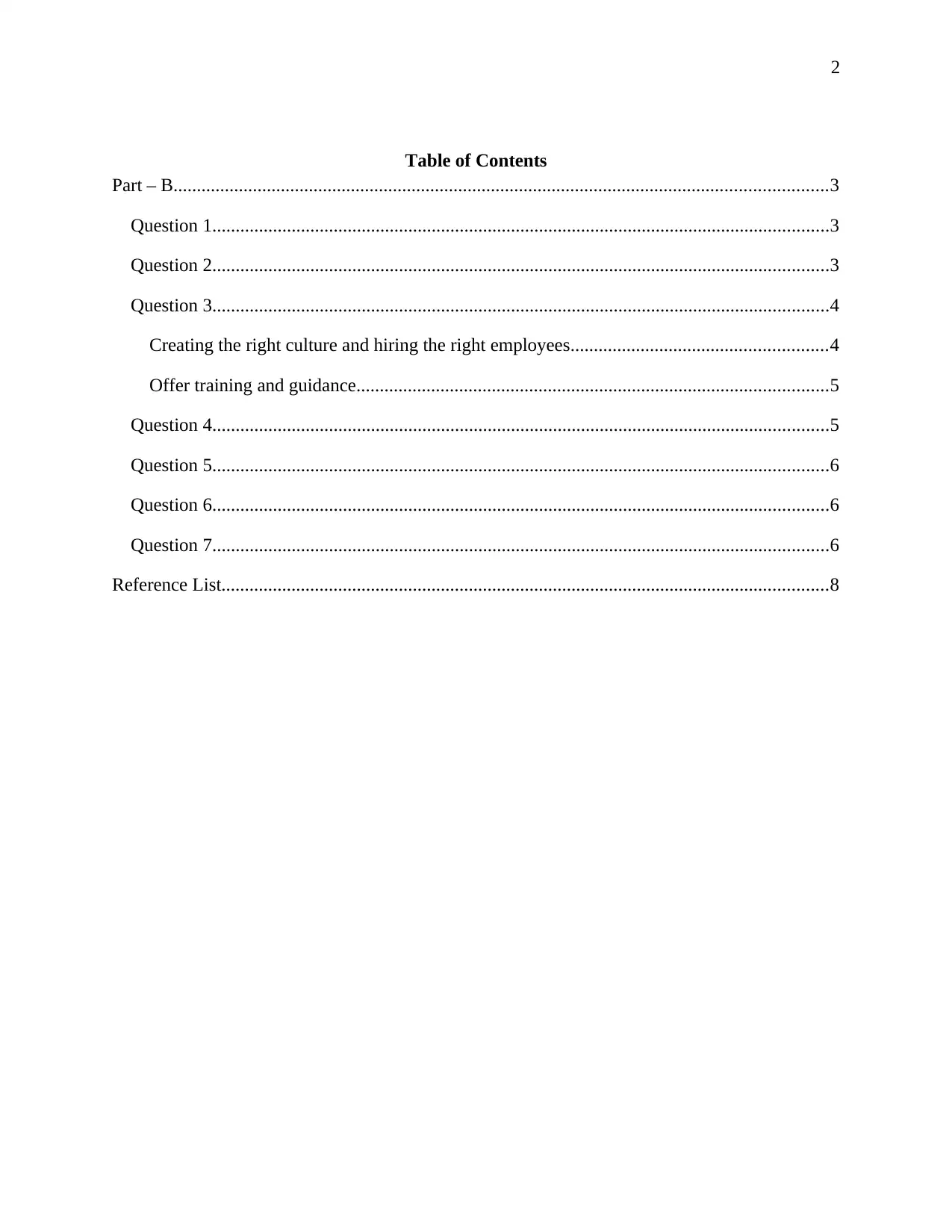
2
Table of Contents
Part – B............................................................................................................................................3
Question 1....................................................................................................................................3
Question 2....................................................................................................................................3
Question 3....................................................................................................................................4
Creating the right culture and hiring the right employees.......................................................4
Offer training and guidance.....................................................................................................5
Question 4....................................................................................................................................5
Question 5....................................................................................................................................6
Question 6....................................................................................................................................6
Question 7....................................................................................................................................6
Reference List..................................................................................................................................8
Table of Contents
Part – B............................................................................................................................................3
Question 1....................................................................................................................................3
Question 2....................................................................................................................................3
Question 3....................................................................................................................................4
Creating the right culture and hiring the right employees.......................................................4
Offer training and guidance.....................................................................................................5
Question 4....................................................................................................................................5
Question 5....................................................................................................................................6
Question 6....................................................................................................................................6
Question 7....................................................................................................................................6
Reference List..................................................................................................................................8
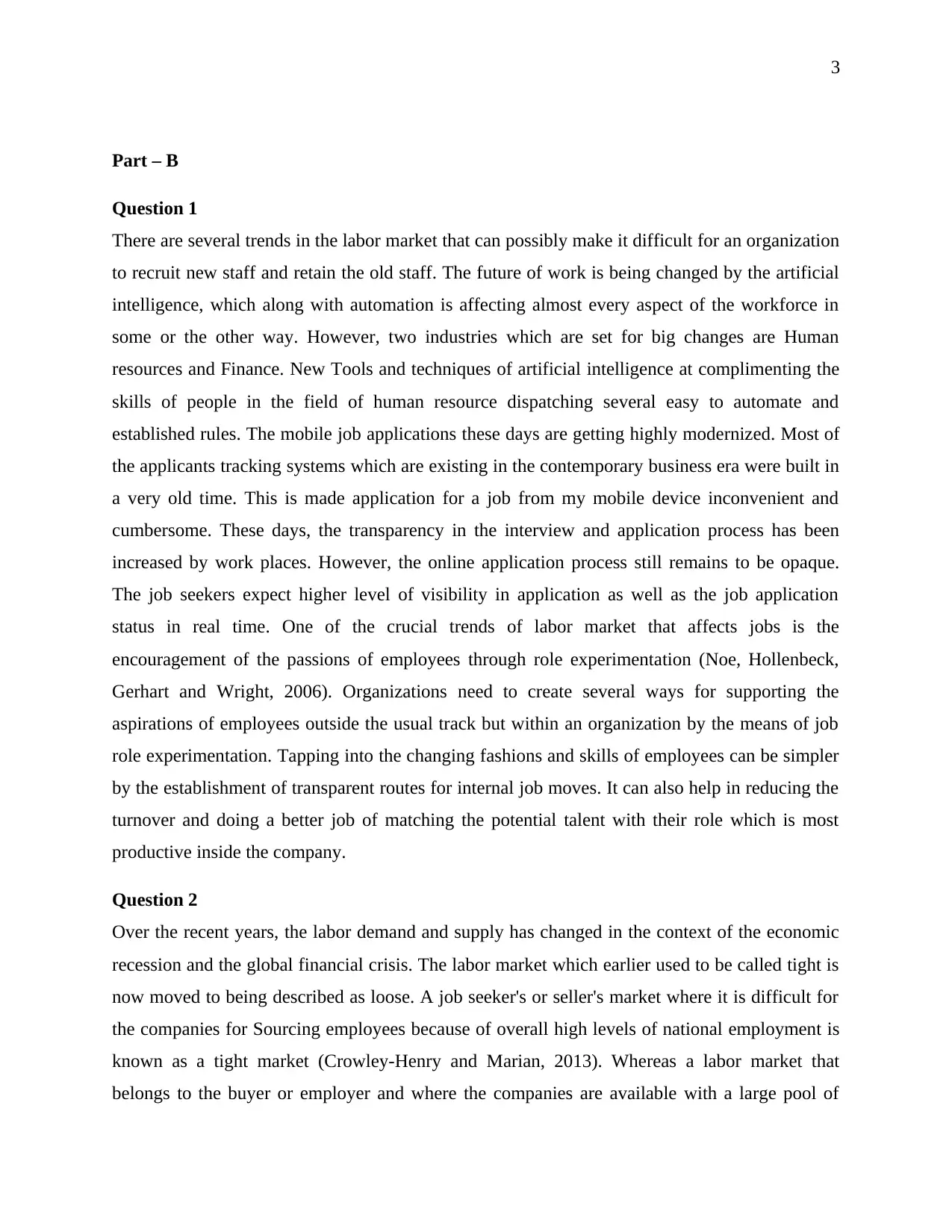
3
Part – B
Question 1
There are several trends in the labor market that can possibly make it difficult for an organization
to recruit new staff and retain the old staff. The future of work is being changed by the artificial
intelligence, which along with automation is affecting almost every aspect of the workforce in
some or the other way. However, two industries which are set for big changes are Human
resources and Finance. New Tools and techniques of artificial intelligence at complimenting the
skills of people in the field of human resource dispatching several easy to automate and
established rules. The mobile job applications these days are getting highly modernized. Most of
the applicants tracking systems which are existing in the contemporary business era were built in
a very old time. This is made application for a job from my mobile device inconvenient and
cumbersome. These days, the transparency in the interview and application process has been
increased by work places. However, the online application process still remains to be opaque.
The job seekers expect higher level of visibility in application as well as the job application
status in real time. One of the crucial trends of labor market that affects jobs is the
encouragement of the passions of employees through role experimentation (Noe, Hollenbeck,
Gerhart and Wright, 2006). Organizations need to create several ways for supporting the
aspirations of employees outside the usual track but within an organization by the means of job
role experimentation. Tapping into the changing fashions and skills of employees can be simpler
by the establishment of transparent routes for internal job moves. It can also help in reducing the
turnover and doing a better job of matching the potential talent with their role which is most
productive inside the company.
Question 2
Over the recent years, the labor demand and supply has changed in the context of the economic
recession and the global financial crisis. The labor market which earlier used to be called tight is
now moved to being described as loose. A job seeker's or seller's market where it is difficult for
the companies for Sourcing employees because of overall high levels of national employment is
known as a tight market (Crowley-Henry and Marian, 2013). Whereas a labor market that
belongs to the buyer or employer and where the companies are available with a large pool of
Part – B
Question 1
There are several trends in the labor market that can possibly make it difficult for an organization
to recruit new staff and retain the old staff. The future of work is being changed by the artificial
intelligence, which along with automation is affecting almost every aspect of the workforce in
some or the other way. However, two industries which are set for big changes are Human
resources and Finance. New Tools and techniques of artificial intelligence at complimenting the
skills of people in the field of human resource dispatching several easy to automate and
established rules. The mobile job applications these days are getting highly modernized. Most of
the applicants tracking systems which are existing in the contemporary business era were built in
a very old time. This is made application for a job from my mobile device inconvenient and
cumbersome. These days, the transparency in the interview and application process has been
increased by work places. However, the online application process still remains to be opaque.
The job seekers expect higher level of visibility in application as well as the job application
status in real time. One of the crucial trends of labor market that affects jobs is the
encouragement of the passions of employees through role experimentation (Noe, Hollenbeck,
Gerhart and Wright, 2006). Organizations need to create several ways for supporting the
aspirations of employees outside the usual track but within an organization by the means of job
role experimentation. Tapping into the changing fashions and skills of employees can be simpler
by the establishment of transparent routes for internal job moves. It can also help in reducing the
turnover and doing a better job of matching the potential talent with their role which is most
productive inside the company.
Question 2
Over the recent years, the labor demand and supply has changed in the context of the economic
recession and the global financial crisis. The labor market which earlier used to be called tight is
now moved to being described as loose. A job seeker's or seller's market where it is difficult for
the companies for Sourcing employees because of overall high levels of national employment is
known as a tight market (Crowley-Henry and Marian, 2013). Whereas a labor market that
belongs to the buyer or employer and where the companies are available with a large pool of
⊘ This is a preview!⊘
Do you want full access?
Subscribe today to unlock all pages.

Trusted by 1+ million students worldwide
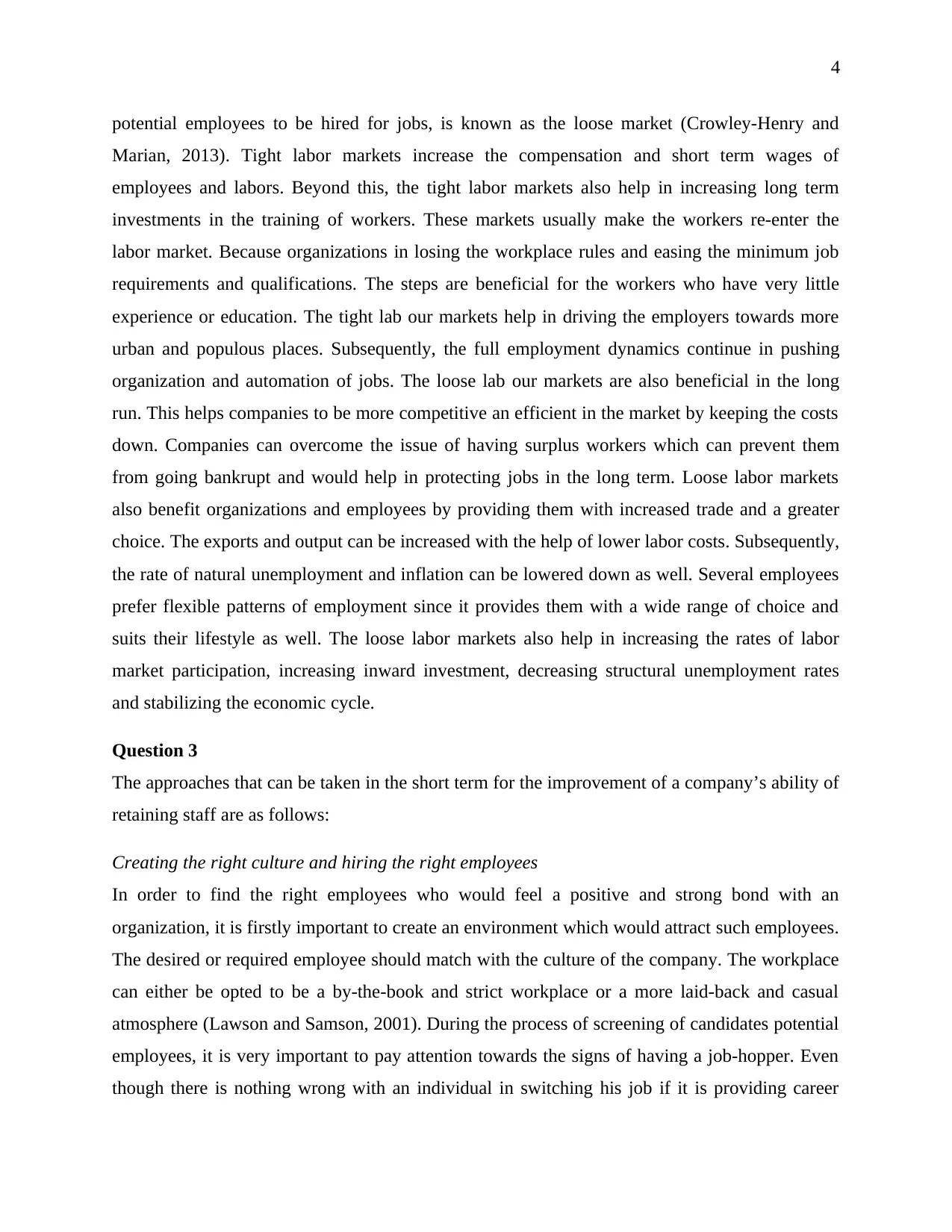
4
potential employees to be hired for jobs, is known as the loose market (Crowley-Henry and
Marian, 2013). Tight labor markets increase the compensation and short term wages of
employees and labors. Beyond this, the tight labor markets also help in increasing long term
investments in the training of workers. These markets usually make the workers re-enter the
labor market. Because organizations in losing the workplace rules and easing the minimum job
requirements and qualifications. The steps are beneficial for the workers who have very little
experience or education. The tight lab our markets help in driving the employers towards more
urban and populous places. Subsequently, the full employment dynamics continue in pushing
organization and automation of jobs. The loose lab our markets are also beneficial in the long
run. This helps companies to be more competitive an efficient in the market by keeping the costs
down. Companies can overcome the issue of having surplus workers which can prevent them
from going bankrupt and would help in protecting jobs in the long term. Loose labor markets
also benefit organizations and employees by providing them with increased trade and a greater
choice. The exports and output can be increased with the help of lower labor costs. Subsequently,
the rate of natural unemployment and inflation can be lowered down as well. Several employees
prefer flexible patterns of employment since it provides them with a wide range of choice and
suits their lifestyle as well. The loose labor markets also help in increasing the rates of labor
market participation, increasing inward investment, decreasing structural unemployment rates
and stabilizing the economic cycle.
Question 3
The approaches that can be taken in the short term for the improvement of a company’s ability of
retaining staff are as follows:
Creating the right culture and hiring the right employees
In order to find the right employees who would feel a positive and strong bond with an
organization, it is firstly important to create an environment which would attract such employees.
The desired or required employee should match with the culture of the company. The workplace
can either be opted to be a by-the-book and strict workplace or a more laid-back and casual
atmosphere (Lawson and Samson, 2001). During the process of screening of candidates potential
employees, it is very important to pay attention towards the signs of having a job-hopper. Even
though there is nothing wrong with an individual in switching his job if it is providing career
potential employees to be hired for jobs, is known as the loose market (Crowley-Henry and
Marian, 2013). Tight labor markets increase the compensation and short term wages of
employees and labors. Beyond this, the tight labor markets also help in increasing long term
investments in the training of workers. These markets usually make the workers re-enter the
labor market. Because organizations in losing the workplace rules and easing the minimum job
requirements and qualifications. The steps are beneficial for the workers who have very little
experience or education. The tight lab our markets help in driving the employers towards more
urban and populous places. Subsequently, the full employment dynamics continue in pushing
organization and automation of jobs. The loose lab our markets are also beneficial in the long
run. This helps companies to be more competitive an efficient in the market by keeping the costs
down. Companies can overcome the issue of having surplus workers which can prevent them
from going bankrupt and would help in protecting jobs in the long term. Loose labor markets
also benefit organizations and employees by providing them with increased trade and a greater
choice. The exports and output can be increased with the help of lower labor costs. Subsequently,
the rate of natural unemployment and inflation can be lowered down as well. Several employees
prefer flexible patterns of employment since it provides them with a wide range of choice and
suits their lifestyle as well. The loose labor markets also help in increasing the rates of labor
market participation, increasing inward investment, decreasing structural unemployment rates
and stabilizing the economic cycle.
Question 3
The approaches that can be taken in the short term for the improvement of a company’s ability of
retaining staff are as follows:
Creating the right culture and hiring the right employees
In order to find the right employees who would feel a positive and strong bond with an
organization, it is firstly important to create an environment which would attract such employees.
The desired or required employee should match with the culture of the company. The workplace
can either be opted to be a by-the-book and strict workplace or a more laid-back and casual
atmosphere (Lawson and Samson, 2001). During the process of screening of candidates potential
employees, it is very important to pay attention towards the signs of having a job-hopper. Even
though there is nothing wrong with an individual in switching his job if it is providing career
Paraphrase This Document
Need a fresh take? Get an instant paraphrase of this document with our AI Paraphraser
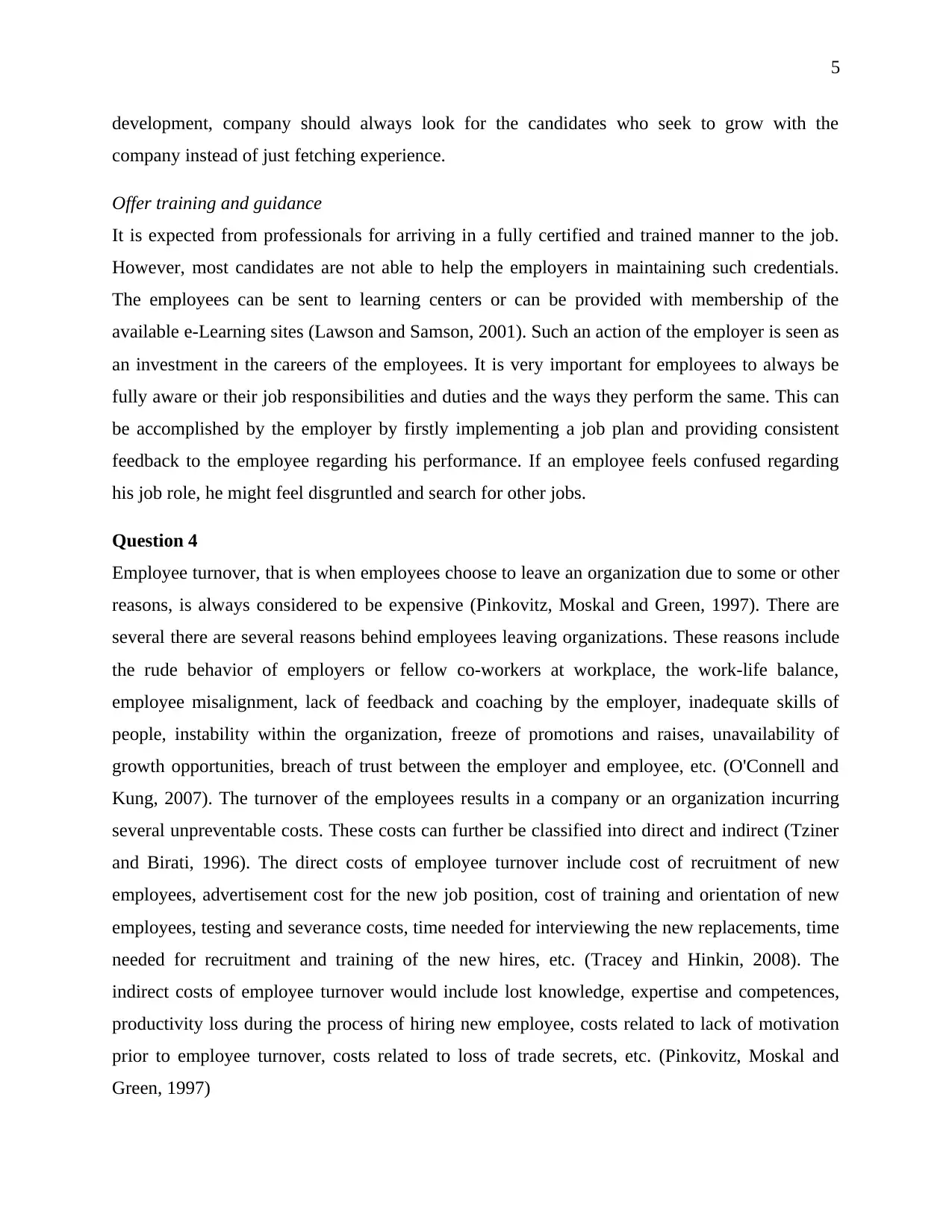
5
development, company should always look for the candidates who seek to grow with the
company instead of just fetching experience.
Offer training and guidance
It is expected from professionals for arriving in a fully certified and trained manner to the job.
However, most candidates are not able to help the employers in maintaining such credentials.
The employees can be sent to learning centers or can be provided with membership of the
available e-Learning sites (Lawson and Samson, 2001). Such an action of the employer is seen as
an investment in the careers of the employees. It is very important for employees to always be
fully aware or their job responsibilities and duties and the ways they perform the same. This can
be accomplished by the employer by firstly implementing a job plan and providing consistent
feedback to the employee regarding his performance. If an employee feels confused regarding
his job role, he might feel disgruntled and search for other jobs.
Question 4
Employee turnover, that is when employees choose to leave an organization due to some or other
reasons, is always considered to be expensive (Pinkovitz, Moskal and Green, 1997). There are
several there are several reasons behind employees leaving organizations. These reasons include
the rude behavior of employers or fellow co-workers at workplace, the work-life balance,
employee misalignment, lack of feedback and coaching by the employer, inadequate skills of
people, instability within the organization, freeze of promotions and raises, unavailability of
growth opportunities, breach of trust between the employer and employee, etc. (O'Connell and
Kung, 2007). The turnover of the employees results in a company or an organization incurring
several unpreventable costs. These costs can further be classified into direct and indirect (Tziner
and Birati, 1996). The direct costs of employee turnover include cost of recruitment of new
employees, advertisement cost for the new job position, cost of training and orientation of new
employees, testing and severance costs, time needed for interviewing the new replacements, time
needed for recruitment and training of the new hires, etc. (Tracey and Hinkin, 2008). The
indirect costs of employee turnover would include lost knowledge, expertise and competences,
productivity loss during the process of hiring new employee, costs related to lack of motivation
prior to employee turnover, costs related to loss of trade secrets, etc. (Pinkovitz, Moskal and
Green, 1997)
development, company should always look for the candidates who seek to grow with the
company instead of just fetching experience.
Offer training and guidance
It is expected from professionals for arriving in a fully certified and trained manner to the job.
However, most candidates are not able to help the employers in maintaining such credentials.
The employees can be sent to learning centers or can be provided with membership of the
available e-Learning sites (Lawson and Samson, 2001). Such an action of the employer is seen as
an investment in the careers of the employees. It is very important for employees to always be
fully aware or their job responsibilities and duties and the ways they perform the same. This can
be accomplished by the employer by firstly implementing a job plan and providing consistent
feedback to the employee regarding his performance. If an employee feels confused regarding
his job role, he might feel disgruntled and search for other jobs.
Question 4
Employee turnover, that is when employees choose to leave an organization due to some or other
reasons, is always considered to be expensive (Pinkovitz, Moskal and Green, 1997). There are
several there are several reasons behind employees leaving organizations. These reasons include
the rude behavior of employers or fellow co-workers at workplace, the work-life balance,
employee misalignment, lack of feedback and coaching by the employer, inadequate skills of
people, instability within the organization, freeze of promotions and raises, unavailability of
growth opportunities, breach of trust between the employer and employee, etc. (O'Connell and
Kung, 2007). The turnover of the employees results in a company or an organization incurring
several unpreventable costs. These costs can further be classified into direct and indirect (Tziner
and Birati, 1996). The direct costs of employee turnover include cost of recruitment of new
employees, advertisement cost for the new job position, cost of training and orientation of new
employees, testing and severance costs, time needed for interviewing the new replacements, time
needed for recruitment and training of the new hires, etc. (Tracey and Hinkin, 2008). The
indirect costs of employee turnover would include lost knowledge, expertise and competences,
productivity loss during the process of hiring new employee, costs related to lack of motivation
prior to employee turnover, costs related to loss of trade secrets, etc. (Pinkovitz, Moskal and
Green, 1997)
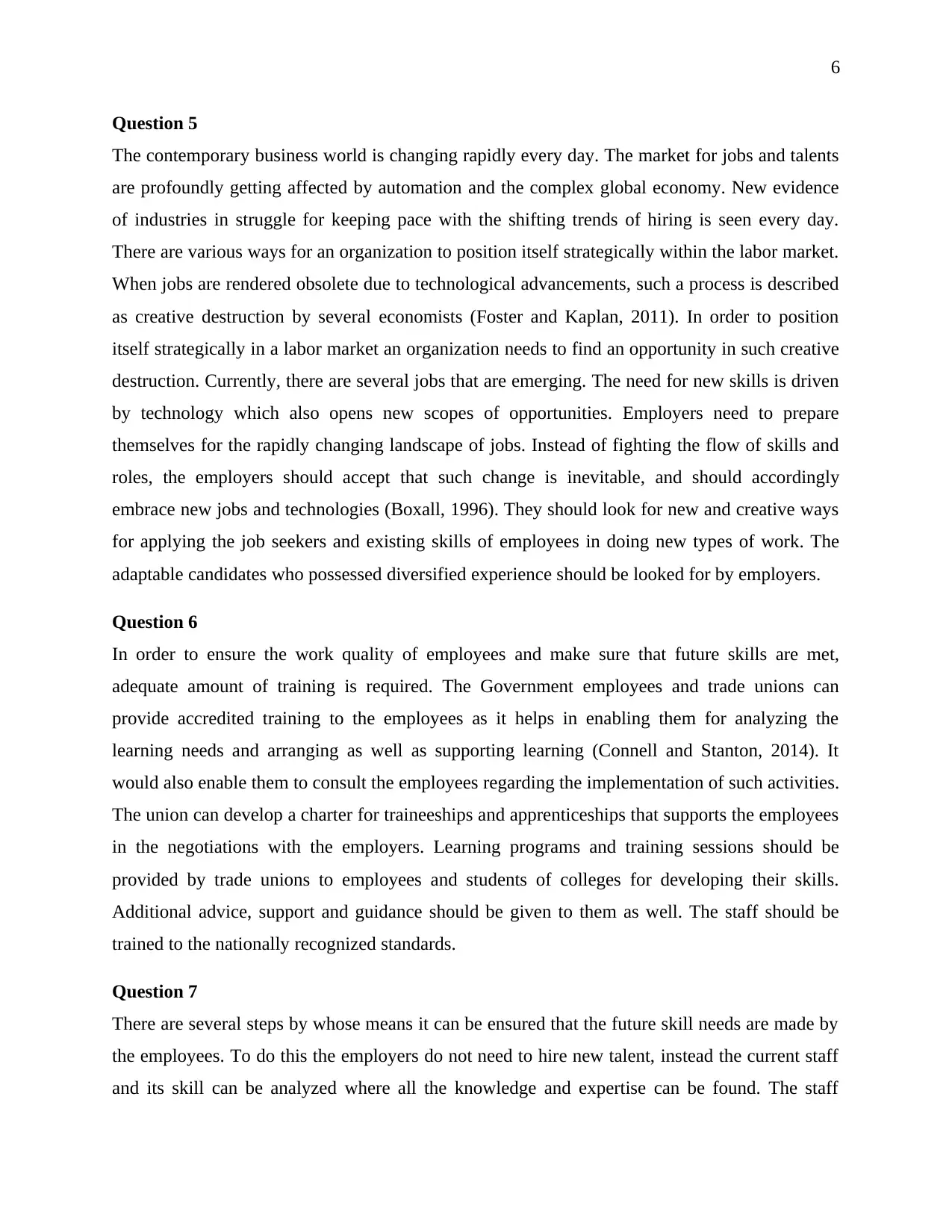
6
Question 5
The contemporary business world is changing rapidly every day. The market for jobs and talents
are profoundly getting affected by automation and the complex global economy. New evidence
of industries in struggle for keeping pace with the shifting trends of hiring is seen every day.
There are various ways for an organization to position itself strategically within the labor market.
When jobs are rendered obsolete due to technological advancements, such a process is described
as creative destruction by several economists (Foster and Kaplan, 2011). In order to position
itself strategically in a labor market an organization needs to find an opportunity in such creative
destruction. Currently, there are several jobs that are emerging. The need for new skills is driven
by technology which also opens new scopes of opportunities. Employers need to prepare
themselves for the rapidly changing landscape of jobs. Instead of fighting the flow of skills and
roles, the employers should accept that such change is inevitable, and should accordingly
embrace new jobs and technologies (Boxall, 1996). They should look for new and creative ways
for applying the job seekers and existing skills of employees in doing new types of work. The
adaptable candidates who possessed diversified experience should be looked for by employers.
Question 6
In order to ensure the work quality of employees and make sure that future skills are met,
adequate amount of training is required. The Government employees and trade unions can
provide accredited training to the employees as it helps in enabling them for analyzing the
learning needs and arranging as well as supporting learning (Connell and Stanton, 2014). It
would also enable them to consult the employees regarding the implementation of such activities.
The union can develop a charter for traineeships and apprenticeships that supports the employees
in the negotiations with the employers. Learning programs and training sessions should be
provided by trade unions to employees and students of colleges for developing their skills.
Additional advice, support and guidance should be given to them as well. The staff should be
trained to the nationally recognized standards.
Question 7
There are several steps by whose means it can be ensured that the future skill needs are made by
the employees. To do this the employers do not need to hire new talent, instead the current staff
and its skill can be analyzed where all the knowledge and expertise can be found. The staff
Question 5
The contemporary business world is changing rapidly every day. The market for jobs and talents
are profoundly getting affected by automation and the complex global economy. New evidence
of industries in struggle for keeping pace with the shifting trends of hiring is seen every day.
There are various ways for an organization to position itself strategically within the labor market.
When jobs are rendered obsolete due to technological advancements, such a process is described
as creative destruction by several economists (Foster and Kaplan, 2011). In order to position
itself strategically in a labor market an organization needs to find an opportunity in such creative
destruction. Currently, there are several jobs that are emerging. The need for new skills is driven
by technology which also opens new scopes of opportunities. Employers need to prepare
themselves for the rapidly changing landscape of jobs. Instead of fighting the flow of skills and
roles, the employers should accept that such change is inevitable, and should accordingly
embrace new jobs and technologies (Boxall, 1996). They should look for new and creative ways
for applying the job seekers and existing skills of employees in doing new types of work. The
adaptable candidates who possessed diversified experience should be looked for by employers.
Question 6
In order to ensure the work quality of employees and make sure that future skills are met,
adequate amount of training is required. The Government employees and trade unions can
provide accredited training to the employees as it helps in enabling them for analyzing the
learning needs and arranging as well as supporting learning (Connell and Stanton, 2014). It
would also enable them to consult the employees regarding the implementation of such activities.
The union can develop a charter for traineeships and apprenticeships that supports the employees
in the negotiations with the employers. Learning programs and training sessions should be
provided by trade unions to employees and students of colleges for developing their skills.
Additional advice, support and guidance should be given to them as well. The staff should be
trained to the nationally recognized standards.
Question 7
There are several steps by whose means it can be ensured that the future skill needs are made by
the employees. To do this the employers do not need to hire new talent, instead the current staff
and its skill can be analyzed where all the knowledge and expertise can be found. The staff
⊘ This is a preview!⊘
Do you want full access?
Subscribe today to unlock all pages.

Trusted by 1+ million students worldwide
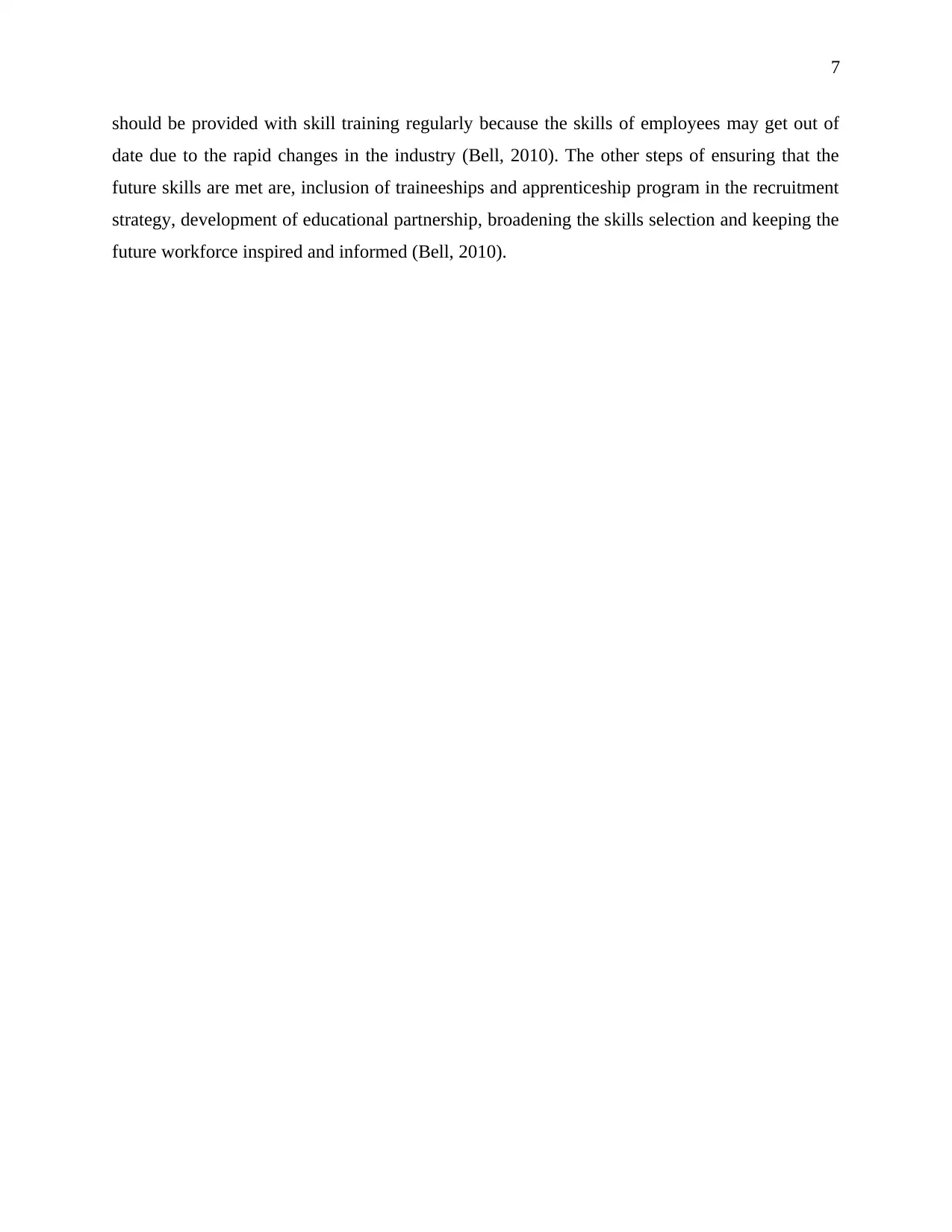
7
should be provided with skill training regularly because the skills of employees may get out of
date due to the rapid changes in the industry (Bell, 2010). The other steps of ensuring that the
future skills are met are, inclusion of traineeships and apprenticeship program in the recruitment
strategy, development of educational partnership, broadening the skills selection and keeping the
future workforce inspired and informed (Bell, 2010).
should be provided with skill training regularly because the skills of employees may get out of
date due to the rapid changes in the industry (Bell, 2010). The other steps of ensuring that the
future skills are met are, inclusion of traineeships and apprenticeship program in the recruitment
strategy, development of educational partnership, broadening the skills selection and keeping the
future workforce inspired and informed (Bell, 2010).
Paraphrase This Document
Need a fresh take? Get an instant paraphrase of this document with our AI Paraphraser
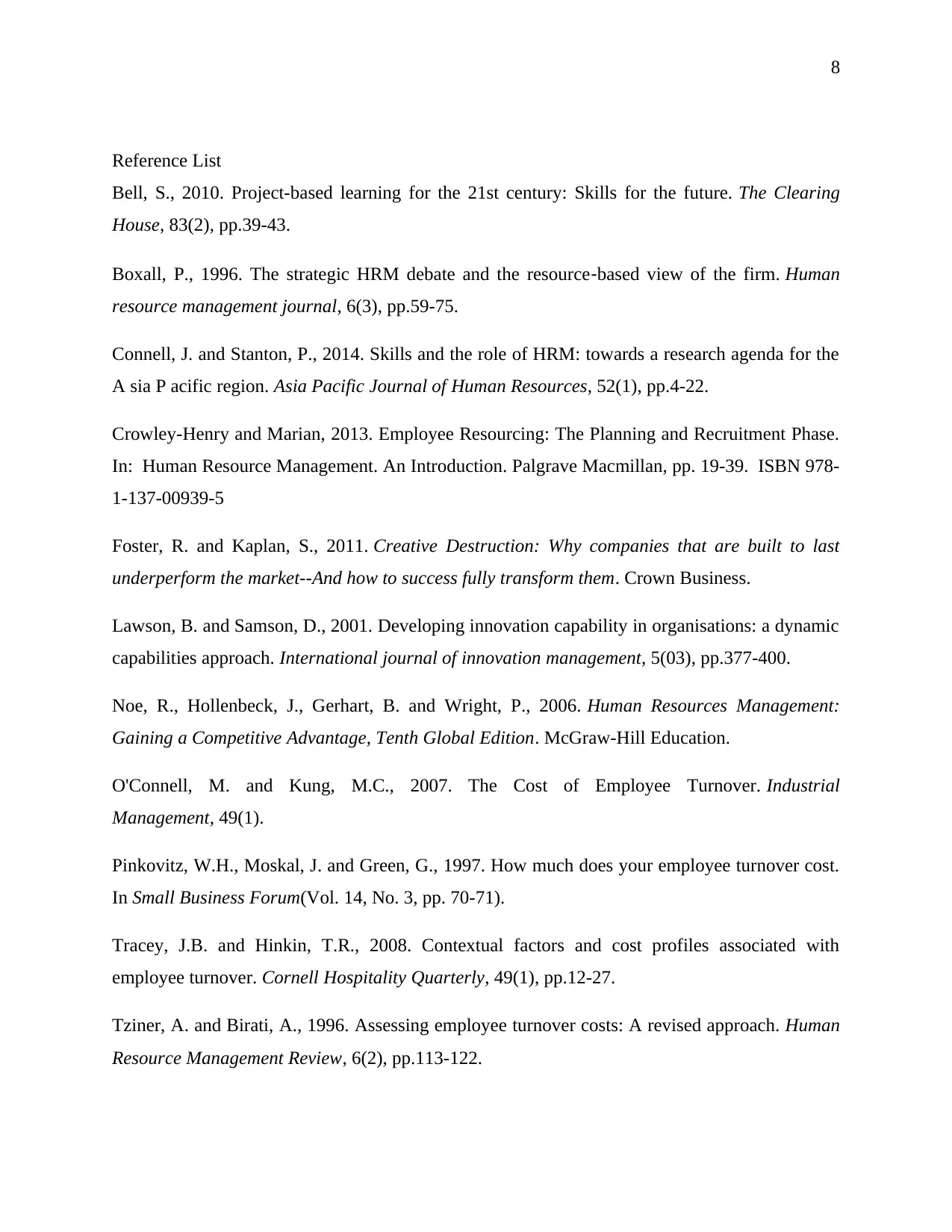
8
Reference List
Bell, S., 2010. Project-based learning for the 21st century: Skills for the future. The Clearing
House, 83(2), pp.39-43.
Boxall, P., 1996. The strategic HRM debate and the resource‐based view of the firm. Human
resource management journal, 6(3), pp.59-75.
Connell, J. and Stanton, P., 2014. Skills and the role of HRM: towards a research agenda for the
A sia P acific region. Asia Pacific Journal of Human Resources, 52(1), pp.4-22.
Crowley-Henry and Marian, 2013. Employee Resourcing: The Planning and Recruitment Phase.
In: Human Resource Management. An Introduction. Palgrave Macmillan, pp. 19-39. ISBN 978-
1-137-00939-5
Foster, R. and Kaplan, S., 2011. Creative Destruction: Why companies that are built to last
underperform the market--And how to success fully transform them. Crown Business.
Lawson, B. and Samson, D., 2001. Developing innovation capability in organisations: a dynamic
capabilities approach. International journal of innovation management, 5(03), pp.377-400.
Noe, R., Hollenbeck, J., Gerhart, B. and Wright, P., 2006. Human Resources Management:
Gaining a Competitive Advantage, Tenth Global Edition. McGraw-Hill Education.
O'Connell, M. and Kung, M.C., 2007. The Cost of Employee Turnover. Industrial
Management, 49(1).
Pinkovitz, W.H., Moskal, J. and Green, G., 1997. How much does your employee turnover cost.
In Small Business Forum(Vol. 14, No. 3, pp. 70-71).
Tracey, J.B. and Hinkin, T.R., 2008. Contextual factors and cost profiles associated with
employee turnover. Cornell Hospitality Quarterly, 49(1), pp.12-27.
Tziner, A. and Birati, A., 1996. Assessing employee turnover costs: A revised approach. Human
Resource Management Review, 6(2), pp.113-122.
Reference List
Bell, S., 2010. Project-based learning for the 21st century: Skills for the future. The Clearing
House, 83(2), pp.39-43.
Boxall, P., 1996. The strategic HRM debate and the resource‐based view of the firm. Human
resource management journal, 6(3), pp.59-75.
Connell, J. and Stanton, P., 2014. Skills and the role of HRM: towards a research agenda for the
A sia P acific region. Asia Pacific Journal of Human Resources, 52(1), pp.4-22.
Crowley-Henry and Marian, 2013. Employee Resourcing: The Planning and Recruitment Phase.
In: Human Resource Management. An Introduction. Palgrave Macmillan, pp. 19-39. ISBN 978-
1-137-00939-5
Foster, R. and Kaplan, S., 2011. Creative Destruction: Why companies that are built to last
underperform the market--And how to success fully transform them. Crown Business.
Lawson, B. and Samson, D., 2001. Developing innovation capability in organisations: a dynamic
capabilities approach. International journal of innovation management, 5(03), pp.377-400.
Noe, R., Hollenbeck, J., Gerhart, B. and Wright, P., 2006. Human Resources Management:
Gaining a Competitive Advantage, Tenth Global Edition. McGraw-Hill Education.
O'Connell, M. and Kung, M.C., 2007. The Cost of Employee Turnover. Industrial
Management, 49(1).
Pinkovitz, W.H., Moskal, J. and Green, G., 1997. How much does your employee turnover cost.
In Small Business Forum(Vol. 14, No. 3, pp. 70-71).
Tracey, J.B. and Hinkin, T.R., 2008. Contextual factors and cost profiles associated with
employee turnover. Cornell Hospitality Quarterly, 49(1), pp.12-27.
Tziner, A. and Birati, A., 1996. Assessing employee turnover costs: A revised approach. Human
Resource Management Review, 6(2), pp.113-122.
1 out of 8
Your All-in-One AI-Powered Toolkit for Academic Success.
+13062052269
info@desklib.com
Available 24*7 on WhatsApp / Email
![[object Object]](/_next/static/media/star-bottom.7253800d.svg)
Unlock your academic potential
Copyright © 2020–2025 A2Z Services. All Rights Reserved. Developed and managed by ZUCOL.